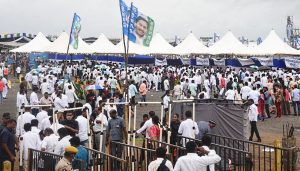The Andhra Pradesh chief minister was unanimously elected YSRCP lifetime president on the second day of a party plenary held in July.
Published Sep 21, 2022 | 11:54 PM ⚊ Updated Sep 21, 2022 | 11:57 PM

AP Chief Minister YS Jagan Mohan Reddy. (Supplied)
The Election Commission of India (EC) has objected to the unanimous election of Andhra Pradesh Chief Minister YS Jagan Mohan Reddy as the YSRCP’s permanent lifetime president.
In an order on Wednesday, 21 September, the ECI said: “The commission categorically rejects, any attempt or even a hint of any organisational post being of permanent nature being inherently anti-democracy. [sic]”
It added: “Any action which denies the periodicity of elections is in complete violation of the extant instructions of the commission. If not categorically contradicted, it has the potential to create confusion in other political formations of such a move (which is widely reported in the press) being condoned by the Election Commission of India and in turn, can assume contagious proportions”
The EC was responding to reports about the election of Jagan as the permanent president of YSRCP.
The poll panel ordered the YSRCP to conclude an internal inquiry at the earliest and make a clear and categorical public announcement contradicting the reports.

Party workers at the YSRCP plenary session on Friday, 8 July, where YS Jagan Mohan Reddy was elected its lifetime president. (Twitter/YSRCParty)
Jagan was unanimously elected lifetime President of the YSRCP on the concluding day of the two-day party plenary held in July.
There were 22 sets of nominations filed on his behalf for the post of national president of the party, and as there was no other nomination, the returning officer declared him president, elected unanimously.
On 9 July, the second day of the plenary, two important amendments to the party constitution were adopted.
The first was changing the name of the party from the Yuvajana Shramika Rythu Congress Party to the YSR Congress Party, which could also be referred to as the YSRCP.
The second was changing the tenure of the post of president to lifetime.
